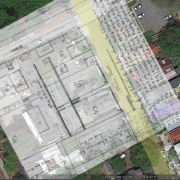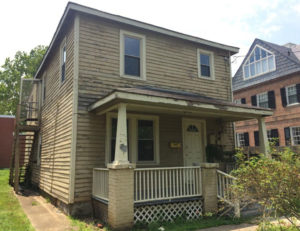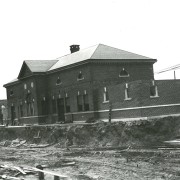Posts
Cooperation for Preservation of Historic Properties
/in Historic Buildings /by HFFI StaffCooperation for Preservation of Historic Properties
by David James, HFFI Board President
Since 1955, the Historic Fredericksburg Foundation, Inc. (HFFI) has been devoted to protecting and preserving historic structures and landscapes of our city that give it a true sense of place and authenticity. Recognizing that each modification of an historic building could impact the integrity of our architectural heritage, the organization takes proposed changes very seriously. Therefore, HFFI has decided to appeal a Certificate of Appropriateness (COA) approved by the Fredericksburg Architectural Review Board (ARB) on December 10, 2018.
The ARB approved replacement of a wooden front porch at the home on 129 Caroline Street with concrete, brick and tile. HFFI has held a restrictive preservation covenant on the property since 1974. It has worked with the current owners on several occasions, including on a well-designed, historically sensitive, and substantial addition made in the early 1990s.
The ARB, HFFI, and many other preservation commissions and organizations are charged with the review of alterations to significant historic resources. They draw from the same professional standards and guidelines, known as the Secretary of Interior’s Standards for the Treatment of Historic Properties. The modifications proposed are in clear violation. These Standards specify that:
— “The distinguishing original qualities or character of a building, structure … shall not be destroyed.”
—“The removal or alteration of any historical material or distinctive architectural features should be avoided when possible.”
—“Deteriorated architectural features shall be repaired rather than replaced, whenever possible.”
In a previous application some time ago, the property owners sought to make similar changes, proposing to replace the wood front porch with brick. This portion of the application was denied by the ARB on grounds that the porch was an important architectural feature of the house.
Because it holds a restrictive covenant in the deed to this property, HFFI has standing in this matter. The homeowners have attempted to void the covenants, but HFFI holds that the covenants cannot be modified or terminated except by the agreement of all parties entitled to enforce the covenant.
Moving forward, HFFI asks that:
—The wood front porch remains in place and be repaired using in-kind materials as the Historic District Handbook and ARB guidelines require, unless the property owners work with HFFI to establish a mutually agreed upon alternative compatible with preservation practices and ARB guidelines in a new COA.
—The ARB adheres to the Secretary of Interior Standards detailed in the Historic District Handbook and articulated by the design standards and guidelines therein.
—The ARB provides HFFI with notice when a request for alteration is made on property covered by one of its covenants.
—It be an active partner in any revision of ARB guidelines.
—City Council reviews its 2012 Memorandum of Understanding with HFFI to clarify the organization’s role in protecting structures in the historic district.
Besides enforcing its restrictive covenant, HFFI hopes that the City Council would give it standing to appeal to the Circuit Court on decisions to raze, demolish, or move any structure in the city. Unfortunately, in the last few years, we have lost historic properties that should not have been destroyed. This is why HFFI was formed in the first place, and so HFFI wants the right to stop this injustice.
Homeowners and building owners are temporary stewards of these unique properties. The organization has partnered with them throughout its history to preserve, protect, and revitalize this great city. With support from the community, HFFI has led the effort to preserve Fredericksburg for the past 64 years. The organization wants the tools to continue these efforts.
1210 Sophia Street
/in Historic Buildings, Local History, Riverfront Development /by HFFI Staff
1210 Sophia Street – Can it be Saved?
By HFFI Staff
(Updated 5/1/2017)
1210 Sophia Street is in danger of being demolished. If the clock runs out—it will be gone. But there is a chance to relocate this 100+ year old property to a new location. YOU can help save it!
Located within Fredericksburg’s Downtown Historic District, 1210 Sophia Street is a contributing resource. This modest building, situated along the Rappahannock River, is an example of housing used by Fredericksburg’s working class residents at the turn of the twentieth century. It is in good condition and structurally sound, but the only option besides demolition is relocation.
The City of Fredericksburg has offered up to $20,000 to aid in the costs of moving the house to an open lot within the city, but no matter of its location it will remain under the purview of the city’s Architectural Review Board and the city’s historic district overlay. But there is a deadline, so don’t delay! Help us get the word out, and this 1890’s house may once again be called a home.
Built in 1894, this two-story house was built for Gilbert C. Walker, an iron worker, and it remained in the Walker family for almost 100 years. The rear addition was added in 1953, (identified through an independent archive of city records), and Sanborn Maps as well as census records round out the history of the house and its residents. (Special thanks to Kate Schwartz, Historic Resource Planner—City of Fredericksburg, for her efforts in researching the history of this home. – Read more about the history of this home here.)
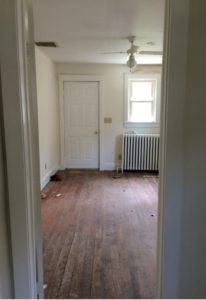
1210 Sophia Street Interior – Photo Credit: Fredericksburg City Staff
Do you own a lot that this building could be moved to? Or perhaps you know someone who does? This is a chance for us to save a historic building from demolition, and HFFI is happy to see the city contributing funds from the Blight Abatement Fund to assist in the project.
Learn more and read the city’s Memorandum to the Architectural Review Board about 1210 Sophia Street (including additional history and applicable Historic District Design Standards & Guidelines).
Also online, read The Free Lance-Star article about the city’s decision to remove the building.
For UMW student, and HFFI intern, Kiernan Ziletti’s perspective on the situation, read his article featured in the March issue of Front Porch Magazine.
Questions or ideas on how to save this historic building? Contact us at office@hffi.org or 540-371-4504, or Kate Schwartz at ksschwartz@fredericksburgva.gov or 540-372-1179.
UPDATE: An open lot near downtown has been located, further details to be worked out. Are you interested in taking on this project? Contact HFFI at 540-371-4504 to learn more.
UPDATE – 5/1/2017:
The official RFP for the sale of this building has been released and can be seen on the Fredericksburg website at http://www.fredericksburgva.gov/bids.aspx?bidID=82
Closing date/ time – 9/21/2017 2:00 PM
Pre-bid Meeting – May 4, 2017, 10AM at site
Contact Person – Lynn Enders
llenders@fredericksburgva.gov
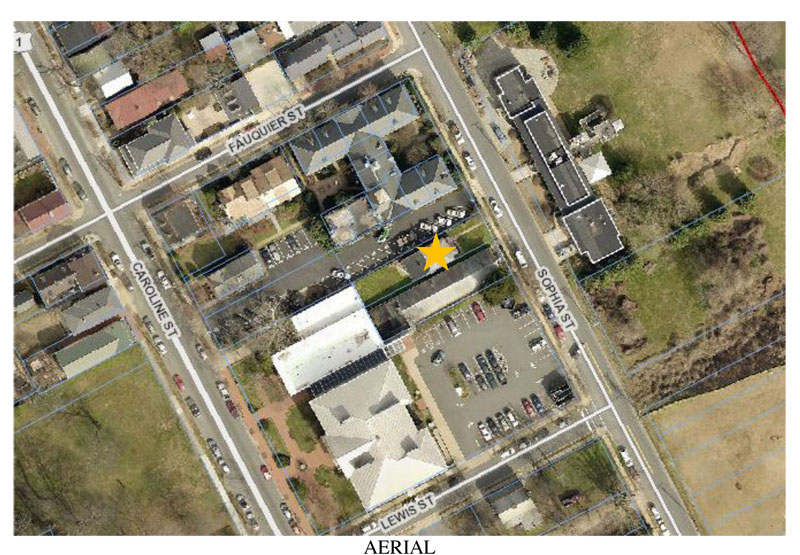
HFFI Letter to the City Re: Townhouses on 300 Block George Street
/in New Development in Downtown /by HFFI Staff
HFFI Letter to the City,
RE: Proposed Townhouses on 300 Block, George Street
In regards to the City’s settlement with JON Properties and the townhouses on the 300 block of George Street HFFI was asked for our input on the updated (9/9/16) building design. Though the scale is not optimal to us, we understand the need for a settlement and want to see the City and all involved parties be able to move forward.
Below is the letter HFFI submitted to City Manager, Tim Baroody in regards to the building design. We hope that JON Properties and City Council will consider these recommendations that we feel increase the building’s compatibility with historic downtown Fredericksburg.
September 16, 2016
Dear Mr. Baroody,
We would like to first thank the City for being open to input from the Historic Fredericksburg Foundation, Inc. (HFFI). It is our hope that by working together we can make the best of the current situation.
HFFI applauds all parties involved for reaching the proposed settlement. We hope that we can do our part to assist in making this building, which is much larger than most buildings in the area, relate to our historic district. It is the details of this project that are of the utmost importance, and will aid in making it more compatible with the Downtown Historic District.
HFFI’s primary goal on this matter is ensuring the project fits into the block’s context and blends into the surrounding streetscape.
Essentially, we have two specific areas of the building that are of the greatest concern and we feel can be adjusted to ensure our goal is accomplished.
Concern #1
The rooftop decks that currently face George Street.
HFFI suggests the rooftop decks be located on the rear elevation.
We feel that of the two options recently presented by JON Properties, in regards to the rooftop decks, the design of rear facing is a better choice. The current building predominantly reflects a period of early-nineteenth century architecture using Federal and Greek Revival style details. The symmetrical balance of the facades with center doors, double hung windows flanked by shutters (both Federal), and the entry porches supported by prominent columns (Greek Revival) reference architectural features similar to those found in the surrounding buildings.
The proposed rooftop decks are not keeping with the stylistic traditions echoed in this building’s design. They not only disrupt the rhythm of the building itself, but also of the entire streetscape when viewing the block. As one approaches the 300 block from the west, the profile of the building would be distinctly different from the surrounding area and immensely out of context.
The adjustment to rear-facing instead of front-facing decks will also remove the conflicting issue of modern and historically reminiscent materials on the George Street elevation. For example, the metal-cable railing and the more traditional railing along the entry stairs, and the rooftop deck exterior cladding are an issue. This relocation would not only place these modern porches in a less-public area, but would allow additional privacy in these spaces and obscure any deck furniture and decorations from the highly public views along George Street.
The Charles Street (west) and “Princess Anne Street”/ Bank Building (east) façades are also profoundly affected by the rooftop balconies. We would like to see the mansard roof fully extended from the front to the rear elevations to avoid appearing “cut out” or half-finished as they do now. This change would produce the needed symmetry, keeping with stylistic traditions seen in the surrounding buildings, for these highly visible elevations and also improve the view of the building when approaching it from a distance.
Concern #2
The Charles Street Façade
HFFI suggests treating the Charles Street elevation as a primary façade due to the building’s location on a corner and highly visible location.
Historically, buildings located on corners treated both street-facing elevations with equal attention. By carrying details used on the primary, George Street, elevation onto the Charles Street elevation it will unify the design. Maintaining the fenestration pattern and its articulation will show the attention to detail this location deserves. We see two significant ways in which this can be accomplished:
Lentils & Sills – the lentils and sills on the Charles Street elevation should match those on George Street, following the hierarchy currently used for each story.
Bay Window – bay windows are a later design element that does not match the style of this project. HFFI suggests removing the bay window from the highly visible Charles Street elevation (as is planned for the east elevation facing the bank building) to create a more coherent unified design on these public elevations and keeping with the symmetry prominently displayed by surrounding buildings.
The bay windows that are currently proposed for the interior units would benefit from a straightening of roof lines to remove the stylistically inappropriate curve now found on them, perhaps employing a hipped or shed roof instead.
The removal of the bay window on the Charles Street elevation should be mitigated by replacing it with 2-3 (symmetrically placed) single, double-hung windows. If having a physical window in the bays that are currently bricked over is an issue, we suggest using a more historically accurate “blind” window that appears to have permanently closed shutters.
As the process of reviewing this project continues, HFFI would ask that City Council be cognizant of the many details found on a building such as this.
Materials – please ask for examples or specifications on materials being used, such as all railings, bricks (color), window mullions, doors, stone detailing, and metal roof materials.
Building methods – please specify details on methods of construction for things such as brick bond, brick mortar joints, application of metal roofs (hand-crimped, etc), and functioning or non-functioning shutters.
HFFI hopes that our input can help JON Properties and City Council develop a building design that reflects the surrounding locations and is better-suited to our city’s Downtown Historic District. The citizens and visitors to Fredericksburg love and appreciate its history, together we can keep that history alive while allowing our city to grow.
Thank you for your time,
HFFI Board of Directors
Barbra Anderson
Paul Eakin
David James
Terrie James
Mary Maher
Danae Peckler
Leslie Pugh
Ed Sandtner
Scott Walker, President
HFFI Staff
Emily Taggart Schricker, Director of Operations
UMW Historic Preservation Department
Michael Spencer, Associate Professor
Oh Hear That Train Whistle Blowin’
/in Historic Buildings /by HFFI Staff
Oh Hear That Train Whistle Blowin’
By Olivia R. Blackwell
Puffs of smoke billowed up from the engine toward the sky and a cheering crowd gathered around the train as it came to a rumbling stop. It seemed as though everyone in town was gathered at the station, eagerly awaiting the door to open. It was October 23, 1886, and President Grover Cleveland stepped off the train to greet the citizens of Fredericksburg.(1) Only two decades prior, the North and South battled over this rail line chartered by the Richmond, Fredericksburg and Potomac Railroad (RF&P). The line that ran through Fredericksburg sat on a strategic point during the Civil War, with both armies laying track to move supplies and then burning it after it was no longer needed. President Cleveland’s stop in Fredericksburg was welcomed by all that day and over 100 years later Fredericksburg came together again to welcome another train’s arrival.

1926 construction of the train bridge across the Rappahannock River.
The turn of the century was the beginning of an exciting new era for train travel in Fredericksburg. Built in 1910 by the RF&P, the Georgian Colonial style train station was a gem standing proudly downtown on what was then known as Prussia Street. The street name paid tribute to the German State of Prussia, which was ruled by Frederick William I in the early 1700s. However, Anti-German sentiment took over when the U.S. entered World War I in 1917 and Fredericksburg demanded a change. City Council voted to rename the street Lafayette Boulevard in 1918, honoring Marquis de Lafayette.(2) A friend of George Washington, Lafayette fought alongside the United States during the Revolutionary War. In 1907, an additional set of tracks connecting Washington, D.C. and Richmond was completed by the RF&P, though Fredericksburg would not join the line until 1927.(3) Along with the new tracks, the bridge over the Rappahannock was finally replaced in 1927.(3) With these additions, the bustling station needed more room to grow. On May 1st, 1927, the citizens of Fredericksburg celebrated the arrival of their new train station; additional wings and a raised platform allowed the station to handle the increased traffic.(3)
The train proved to be a vital asset during wartime. The government relied on the RF&P heavily during WWII to move soldiers and supplies, so much so that traffic on the rails at this time was at its highest point in RF&P history.(3) After the war was won and soldiers returned home, the automobile quickly found its way onto America’s growing stretches of roadways. The average American family now owned a car and no longer wanted to sit on a train to get where they needed to go. The station held on for a few more decades, but eventually faded into the background. In December 1976, Amtrak closed the ticket office and the station became unmanned. With only a caretaker on site only on weekdays (locals may remember caretaker Archie Elder), the station soon fell victim to neglect. Paint peeled off of the walls, the roof leaked onto the few passengers who continued to use the station, and dark corridors became a haven for unlawful activity and vandals.
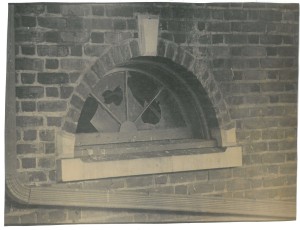
Broken window at Fredericksburg Train Station before renovation.
The first big break in the journey to a rehabilitated station was Amtrak’s allocation of $50,000 for a new passenger platform roof in 1980. Amtrak was confident that the station rehabilitation might not cost as much as originally thought and that no other major work was needed.(4) Work on the roof was to begin in August of that year, but was delayed as the roof, and the riders, would have to wait. During the years that followed, riders were left to defend themselves against both the criminal and decaying structural elements that were making the station an eyesore on the historic downtown. To make matters worse, the station was not regularly inspected. In order to be inspected, the city had to declare it unsafe. To answer the public safety outcry, Amtrak and the RF&P teamed up with local police in 1988 to patrol the station daily.(5) The patrols were a success, but the floors were still crumbling, graffiti covered the walls, and corridors remained dark at night.
In June 1989, RF&P and Amtrak put an additional $200,000 toward the rehabilitation effort. These funds were only allocated to cover the bare bones of the building. The leaking roof, crumbling concrete, broken lights and windows would be fixed, but all cosmetic needs would have to wait.(6) Both the RF&P and Amtrak’s initial plans for the rehabilitation of the station did not comply with the city’s regulations for the renovation of a building in the historic district. The Architectural Review Board refused to permit the changes both companies proposed for the station, due to alterations such as removal of the original canopies over the passenger platforms and installation of modern glass shelters.(7) The RF&P claimed that they were not familiar with regulations for buildings in historical districts when they made their initial plan.(7)
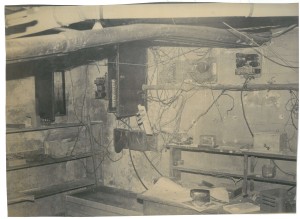
Interior photo of the Fredericksburg Train Station before renovation.
Throughout the 1980s and 90s, the Historic Fredericksburg Foundation, Inc. regularly advocated on behalf of the Fredericksburg train station. HFFI worked with city entities, ranging from City Council to the Architectural Review Board, to gather support and momentum for the preservation and rehabilitation of the station. The Foundation stressed rehabilitation and staying true to the historic design of the building, as opposed to a complete overhaul and modern redesign. HFFI was not only concerned with conserving the historical integrity of the building, but was also worried about the growing safety threat the decaying station had on the downtown community. Train riders and City Council members alike were eager to say goodbye to the crumbling train station and the dangers that came along with it. However, getting Amtrak, the RF&P, and local entities to agree on a deal to bring the Fredericksburg train station back to life would prove to be more difficult than any party imagined.
During this same time period, the RF&P reviewed the possibilities of turning the train station into a bustling center of commerce and downtown tourism; retail and factory outlet stores and tour coaches.(8) However, the RF&P was never able to negotiate a deal for redeveloping the station for retail. With no plans in place, the station continued to decay. Members of City Council grew impatient and made their voices heard. In the winter of 1989 Councilman Robert C. Wheeler referenced the large amount of money the RF&P spent on rail facilities in Richmond and Northern Virginia and urged the RF&P that it was time to invest in Fredericksburg.(9) Councilman H. William Greenup said it was “high time” that the station get restored and pressed for a time frame to hold all parties accountable.(8) Former Councilman W. Sidney Armstrong was disillusioned with the project, telling The Free Lance-Star in January, “I’m not sure there will ever be a whole lot done.”(9)
When work on the passenger platform roof finally started in 1990, things got off to a slow and frustrating start. After Amtrak and the RF&P removed the roof, work slowed to a halt. Upon spending roughly $65,000 on asbestos removal and setting aside another $135,000 for stabilizing the platform, both companies wanted to trim costs. (10) They hired inexpensive labor and sourced volunteer work from the community, to even include new cornice work done by a James Monroe High School shop class. Riders were still able to use the station during this time, but unfortunately, there was no roof to protect them from the elements. Councilman Gordon W. Shelton told The Free Lance-Star, “Stupidity tore the roof off before they had a plan in place.”(11)
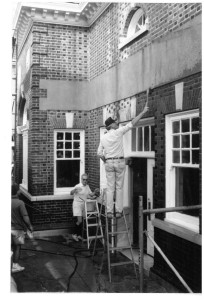
Volunteers donate their time to bring the neglected Fredericksburg Train Station back to its previous glory.
The Virginia Railway Express (VRE) commuter rail was another issue hanging in the balance in 1990. City Council approval of a line through the town meant more riders and increased cooperation from Amtrak and RF&P to invest in Fredericksburg’s historic station.(10) Though downtown citizens, HFFI, and city entities were eager to bring more visitors to their historic town and revitalize the area, there were still concerns to be had, given the companies’ reluctance to fully support the station’s continued use. Chief among them, parking and traffic, which had to be carefully planned for and accommodated without significantly changing the character of the area.(12) To help fund the project, the city started collecting a 2% tax on gasoline in August 1990. By September 1991, the tax raised $800,000 for the city to put toward construction costs.
In early 1992, things were finally starting to look up. The Architectural Review Board had approved a design for a new VRE passenger platform adjacent to the old station and the first commuter train was scheduled to arrive in town June of that year.(13) Executive Director of HFFI, Catharine Gilliam, was pleased with the plan, which included new windows and lights in the passenger shelter that reflected the original design. Unfortunately, the initial bids on the project came in $350,000 too high, forcing the city to take a step back.(14) The platform design was revised, and work got off to a late start in April 1992. Construction crews worked around the clock during the weekend leading up to the opening of the station. The new VRE platform had ticket machines and was handicap accessible. On July 20, 1992, excited commuters left on the first VRE train out of Fredericksburg at 5:29 a.m.(15)
Though this was a hard-fought victory for Fredericksburg, both HFFI and citizens still hoped that something would be done with the old station across from the new VRE line. In 1992 the city submitted a proposal seeking federal grant money to aid in the rehabilitation of the station.(16) With $500,000 eventually awarded from the federal government to use on the rehabilitation, Fredericksburg was ready to make their station dreams a reality. Three years later, the station finally had a buyer. Business owners Gary and Catherine Musselman moved to Virginia in the early 1990s to find the old station in a sorry state. Inspired by the building’s history and potential, they signed a deal to buy it from the RF&P in 1995.(17) Joined by restaurant owner Claiborne Thomasson, the three put one million dollars toward the project, in addition to the $500,000 federal grant, and got to work.(18) Claiborne’s opened in October 1997 to great acclaim, ushering in a new era of fine dining in Fredericksburg, and breathing new life into the train station.
Today, the train station is once again the pride of Fredericksburg. Serving 117,423 riders annually, the station is a hive of activity in the historic downtown.(19) The station connects Richmond, Fredericksburg, and Washington, D.C., giving commuters and travelers alike an alternative to the gridlock on Interstate 95. Amtrak runs six trains through the station daily. Weary train riders searching for a bite to eat need not look far. The Bavarian Chef, a restaurant specializing in authentic German cuisine, is housed in the interior of the old train station. Although Fredericksburg Amtrak train riders can no longer buy a ticket to their destination at the old station, they can still admire the historic building and hear the train whistle blow as it rolls into town.
Sources
-
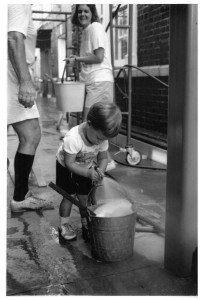
A young helper does his part during an HFFI volunteer clean-up day at the Fredericksburg Train Station
Wrenn, Tony P. “Tracking train station’s history.” The Free Lance-Star, February, 1999. Accessed April, 2016. https://news.google.com/newspapers?id=3wMzAAAAIBAJ&sjid=iAgGAAAAIBAJ&pg=3630%2C1271095
- Alvey Jr., Edward. The Streets of Fredericksburg. Fredericksburg: The Mary Washington College Foundation, Inc., 1978.
- Pearce, John N. and students. “Gateway and Focal Point: Preservation Planning for Fredericksburg’s RF&P Station and for the Area Adjacent to it.” Mary Washington College Department of Historical Preservation, 1987.
- Giegerich, Steve. “New Roof tops train station needs.” The Free Lance-Star, May, 1980. Accessed April, 2016. https://news.google.com/newspapers?nid=1298&dat=19800530&id=jfpNAAAAIBAJ&sjid=gIsDAAAAIBAJ&pg=1994,4682880&hl=en
- Toler, Jim. “Station showing its age.” The Free Lance-Star, January, 1989.
- Hedelt, Rob. “Rail lines agree to fix station here.” The Free Lance-Star, June, 1989.
- Toler, Jim. “Preservation dispute delays station project.” The Free Lance-Star, July, 1989.
- Toler, Jim. “Councilman seeks action on station.” The Free Lance-Star, January, 1989.
- The Free Lance-Star, “‘Eyesore’ station stirs vote for action.” January, 1989.
- Toler, Jim. “Railroad trying to stretch its repair dollar.” The Free Lance-Star, June, 1990. Accessed April 2016. https://news.google.com/newspapers?nid=1298&dat=19900605&id=IfxNAAAAIBAJ&sjid=kIsDAAAAIBAJ&pg=4627,850490&hl=en
- Toler, Jim. “Renovations stalled; Fredericksburg train station continues to deteriorate.” The Free Lance-Star, August, 1990. Accessed April 2016. https://news.google.com/newspapers?nid=1298&dat=19900816&id=WftEAAAAIBAJ&sjid=BowDAAAAIBAJ&pg=5440,2763360&hl=en
- Catharine Gilliam to Tony Hooper, memorandum, December 18, 1991.
- The Free Lance-Star, “Design for commuter rail station approved.” January, 1992.
- Burke, Robert. “City races to finish station.” The Free Lance-Star, July, 1992. Accessed April, 2016. https://news.google.com/newspapers?nid=1298&dat=19920718&id=Uf9NAAAAIBAJ&sjid=w4sDAAAAIBAJ&pg=5924,2824985&hl=en
- Lease, Daryl, and Jim Toler. “Commuters climb on board.” The Free Lance Star, July, 1992. Accessed April, 2016. https://news.google.com/newspapers?nid=9fRKRCJz75UC&dat=19920720&printsec=frontpage&hl=en
- Toler, Jim. “Commuter rail seeks federal funds to add service.” The Free Lance Star, May, 1992. Accessed April, 2016. https://news.google.com/newspapers?nid=1298&dat=19920508&id=DOJLAAAAIBAJ&sjid=1YsDAAAAIBAJ&pg=1453,4291912&hl=en
- Dennen, Rusty. “Would be buyers want fix station.” The Free Lance Star, June, 1992. Accessed April, 2016. https://news.google.com/newspapers?nid=1298&dat=19960606&id=AtYyAAAAIBAJ&sjid=ywcGAAAAIBAJ&pg=6407,1015165&hl=en
- Byrd, Ted. “A railside renaissance.” The Free Lance Star, October, 1997. Accessed April, 2016. https://news.google.com/newspapers?nid=1298&dat=19971010&id=jS4zAAAAIBAJ&sjid=eAgGAAAAIBAJ&pg=4247,2270020&hl=en
- “Station Facts.” Great American Stations. Accessed April 2016. http://www.greatamericanstations.com/Stations/FBG.
Contact Us
Historic Fredericksburg Foundation, Inc.
1200 Caroline Street
Fredericksburg, VA 22401
540-371-4504
office@hffi.org

